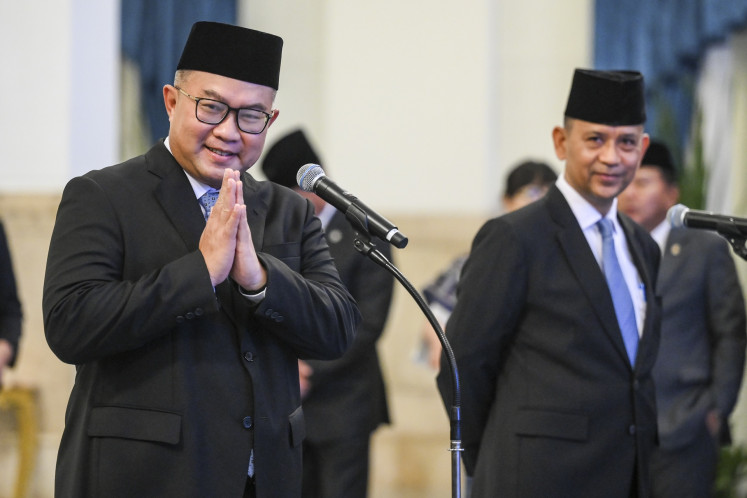Popular Reads
Top Results
Can't find what you're looking for?
View all search resultsPopular Reads
Top Results
Can't find what you're looking for?
View all search resultsKi Saroyo: Gamelan-making maestro
Ganug Nugroho AdiThe man is a famous empu or master craftsman of gamelan, specializing in gong making
Change text size
Gift Premium Articles
to Anyone
G
span class="caption" style="width: 467px;">Ganug Nugroho AdiThe man is a famous empu or master craftsman of gamelan, specializing in gong making. But rather than becoming an overnight maestro, he achieved his expertise after almost 40 years of practice forging gamelan instruments.
Ki Saroyo, the empu, began his career as a worker apprenticed to several gamelan workshops known as besalen in Surakarta and Sukoharjo, Central Java. He spent decades working hard as a forger and tuner of gamelan.
“Poverty brought me to the world of gamelan. I used to be ashamed of being a dropout. But now I often joke that I was really lucky to be a poor man,” Saroyo said, laughing, at his own besalen in Wirun village in Bekonang, Sukoharjo.
Born in Sukoharjo on April 11, 1955, Saroyo only finished junior high. His father, Kromo Prawiro, died when he was in elementary school. His mother, Satinem, was a farm laborer and could not afford to send him to high school. At 16, Saroyo followed in his older brothers’ footsteps by apprenticing with gamelan workshop owner Sumo Kuwat.
In the first year he tended the workshop’s mrapen or open fireplace, preparing firewood and charcoal to burn iron, copper, tin and bronze — the main materials for forging gamelan. “We worked in order to survive and buy rice. We had since childhood consumed tiwul [food made of dried cassava]. Every afternoon we gave part of our pay to mother for some rice,” recalled the fifth of eight children.
Saroyo became a “fireman” in his third year of apprenticeship, with the tougher task of determining how long to burn metals in the fire while turning metal bars being burnt many times for easier forging later on. “It required a lot of strength to turn the bars with a long metal rod. It was exhausting and very hot because I stood close to the blazing fire,” he said.
It took two years before he could work as a metal forger, which was no less difficult because the hammering had to be done properly rather that merely with brute strength. It was at this stage of gamelan making that Saroyo began to learn the tones of the traditional music, always watching how Sumo Kuwat tuned the percussion instruments.
Apart from learning at the workshop, Saroyo also frequently watched gamelan performances to make himself more sensitive to gamelan notes, besides reading gamelan history, gamelan masters’ biographies and studying slendro (pentatonic) and pelog (heptatonic) notes on the gamelan music scale. “I had to know the tones and everything about gamelan to get a better job,” he said.
His boss seemed to notice Saroyo’s talent. He was asked to help tune the instruments now and again, finally leading to Saroyo’s promotion from forger to tuner. “After about five years’ toil in the fireplace, I was eventually entrusted with the tuning work,” he said.
In 1983, Saroyo braced for a bigger challenge by working as a protégé of Ki Tentrem, a gong specialist from the Surakarta Palace, in Ngepung in Pasar Kliwon, Surakarta.
Ki Tentrem was a well-known empu who produced gongs as ordered by the palaces of Surakarta and Yogyakarta.
In this besalen, Saroyo’s gamelan- making skills were further honed, particularly the forging of large gongs of 90 cm, 95 cm and 105 cm in diameter. Gongs 105 cm in diameter are now extremely rare because they can only be crafted by gong maestros.
As a gamelam master craftsman, Saroyo observes the rituals normally practiced by his seniors, such as fasting on Monday and Thursday and meditating at a number of places considered sacred. “This is meant as a plea for God’s blessing so that greater strength is bestowed on me to carry on my gamelan making,” he said.
In 1987 Saroyo’s life changed when the father of three met with KRT Saptono, a relative of the Yogyakarta sultanate’s family and a lecturer at the Indonesian Arts Institute (ISI) in Yogyakarta. Saptono took him to Japan to tune Javanese gamelan there and introduced him to academics at Japan’s arts institutes.
From 1987 to 1993, Saroyo traveled a lot between Indonesia and Japan to speak at workshops and tune gongs. In Japan he also met with a number of gamelan masters from Bali, which he described as important in the expansion of his knowledge of Balinese gamelan.
“In 1993 I left Ki Tentrem’s besalen to open my own gamelan business. At first I used my neighbor’s workshop due to capital shortage,” said Saroyo, who once made a complete gamelan set as ordered by Surakarta King Paku Buwono XII.
Now skilled in forging Balinese gamelan instruments as well, Saroyo even opened a workshop in Bali to meet the many orders he received. “In Bali, they usually order gongs. I can actually make them here [in Wirun village], but the transportation cost is high. So I work in Bali as well to save money,” said the owner of the Palu Gongso workshop.
With almost 40 years’ experience, he has produced thousands of gamelan instruments. The price of a gamelan set varies from Rp 200 million (US$21,200) to Rp 500 million, depending on the quality of the bronze and tin used. It takes around four to five months to finish a complete set.
Saroyo even experienced a slice of fame when President Susilo Bambang Yudhoyono ordered a gamelan set for the presidential palace. Saroyo has also received gamelan orders from Japan, Singapore, Malaysia, the US and Canada, and has visited the countries to give workshops and tune instruments.
No wonder gamelan music expert Rahayu Supanggah and Javanese classical music specialist Aloysius Suwardi, both from ISI Surakarta, on June 2 chose Saroyo to produce a complete set worth Rp 650 million, ordered by KPA Wiwoho Basuki Cokrohadiningrat, a coal entrepreneur.
“Only after those decades was I finally entrusted with the job of creating a very complete set, which is very special because it includes a 105-cm gong with a metal alloy containing gold,” Saroyo said.










